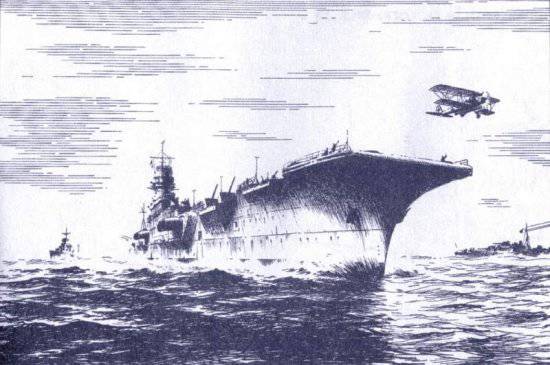Prewar aircraft carriers of the USSR
September 7 1937 of the Year, pursuant to the decree of the Defense Committee of the Council of People's Commissars (SNK) of the USSR on 13 / 15 of August 1937, No. 87, Kommersant Voroshilov, Commissar of Defense of the USSR, sent a report to the Central Committee of the CPSU (B.) I. V. Stalin and the Chairman of the SNK V. M. Molotov on the revised plan for the construction of warships of the Red Forces Naval Forces. In this document, in particular, the increase in the total tonnage of ships of the main classes compared to previous plans was motivated by the introduction of heavy cruisers and aircraft carriers into the construction program. In total it was planned to build two aircraft carriers - for the Northern and Pacific fleets. The laying of the first was planned in 1941, the second in 1942, with the delivery of these ships in the fourth five-year plan. The program of military shipbuilding for the third five-year plan was not approved, but work on the aircraft carrier, which received the designation "project 71", began.
27 June 1938 was sent to the Shipbuilding Directorate of the RKKF tactical-technical assignment (TTZ) for the design of this ship. In October of the same year, the TTZ was reviewed at the Main Naval Headquarters of the RKKF and, with minor remarks, was ordered to prepare it as an assignment for the Shipbuilding Industry Commissariat (NSCP) to create a pre-draft project. This task was no longer included in the list of NKSP design works for 1939, and it was included in the industry order, approved by 29 in November, for 1940 year. But already in January of 1940, it turned out that the NKSP unilaterally did not accept eleven items of the new order, including the task of pre-sketch design of an aircraft carrier. Since the order turned out to be more pressing issues than the aircraft carrier, the question of it in the government was not raised.
Thus ended the project 71, and the outbreak of the Great Patriotic War immediately stopped all work begun on it.
During the war years, the Naval Academy conducted research work on the topic “Development trends of the warship”, within which a pre-sketch design of the aircraft carrier was created using the existing 1943 design, as well as materials from a group of specialists who visited the war in 71 built on the German aircraft carrier "Graf Zeppelin." The completion of this research project in 1944 coincided with the government’s decision to design a new generation of warships based on the experience of the Second World War. In development of this decree, in January 1945, on the orders of the People's Commissar of the Navy, a number of commissions were created with the task of preparing proposals for the selection of the necessary types of warships, including aircraft carriers. However, in parallel with this, in the CRI-45, as early as in 1944, work on the aircraft carrier project, which received the designation “72 Project”, was resumed.
With a standard 23 700 displacement and full - 28 800, this ship should have a length along the waterline 224, width 27,9, depth of the 20,9, draft with a standard displacement 7,23 and at full - 8,45 m. operating from eight boilers with an output of 36 t / h, would provide the aircraft carrier with a full speed of 000 knots and a cruising range of 73 with a nodal course of 30 miles. Reservations were foreseen: onboard — 18 mm, 10000-mm flight and 90-mm hangar decks. On the ship it was planned to install only anti-aircraft guns. Eight paired 30-mm universal B-55-U turret guns with two sets of firing controls (PUS) “Change” were designed for the destroyers of 130 Ave and the leaders of 2 Ave in pre-war years. However, their development was not out of the design stage at that time and was subsequently abandoned. The situation was better with eight paired 35-mm universal 40-K turret gun mounts with four sets of Soyuz SS. The artillery guns and fire control devices themselves were already mass-produced, and the two-gun turret was being prepared for tests. Subsequently, this system weapons installed on the destroyers of the Pr. Z0K and 30-bis. In addition, the aircraft carrier was supposed to put twelve paired 37-mm anti-aircraft guns B-11 and twenty-four new paired 23-mm anti-aircraft guns. The latter were just being developed, but then preference was given to 25-mm guns based on the 84-KM artillery system. The basis of the aircraft’s aircraft armament was 30 aircraft. To ensure their flights, catapults, aerofinisers, pitching quenchers, special landing lights, etc. were provided for. The issues of storing aviation fuel and its supply to airplanes were specifically worked out. Thus, the gas storage facility was separated from the adjacent premises by special flooded cofferdams.
Jet fuel in tanks was under pressure in an inert gas medium, and the gas pipelines themselves passed through a pipe filled with the same gas. The crew consisted of up to 2000 people.
The already mentioned special commission, which worked at the beginning of 1945 and worked out requirements for aircraft carriers, came to the conclusion that the ship, pr. 72, did not quite correspond to them. It turned out that the command fleet, with a clear understanding of the need for ships of this class as part of the Navy, it did not fully determine its attitude to the concept of their construction.
Most likely, this circumstance was not the main reason, but it largely influenced the fact that in the 27 November approved 1945 year of the new shipbuilding program for 1946 — 1955 years there were no aircraft carriers.
- http://navycollection.narod.ru"rel =" nofollow ">http://navycollection.narod.ru


Information